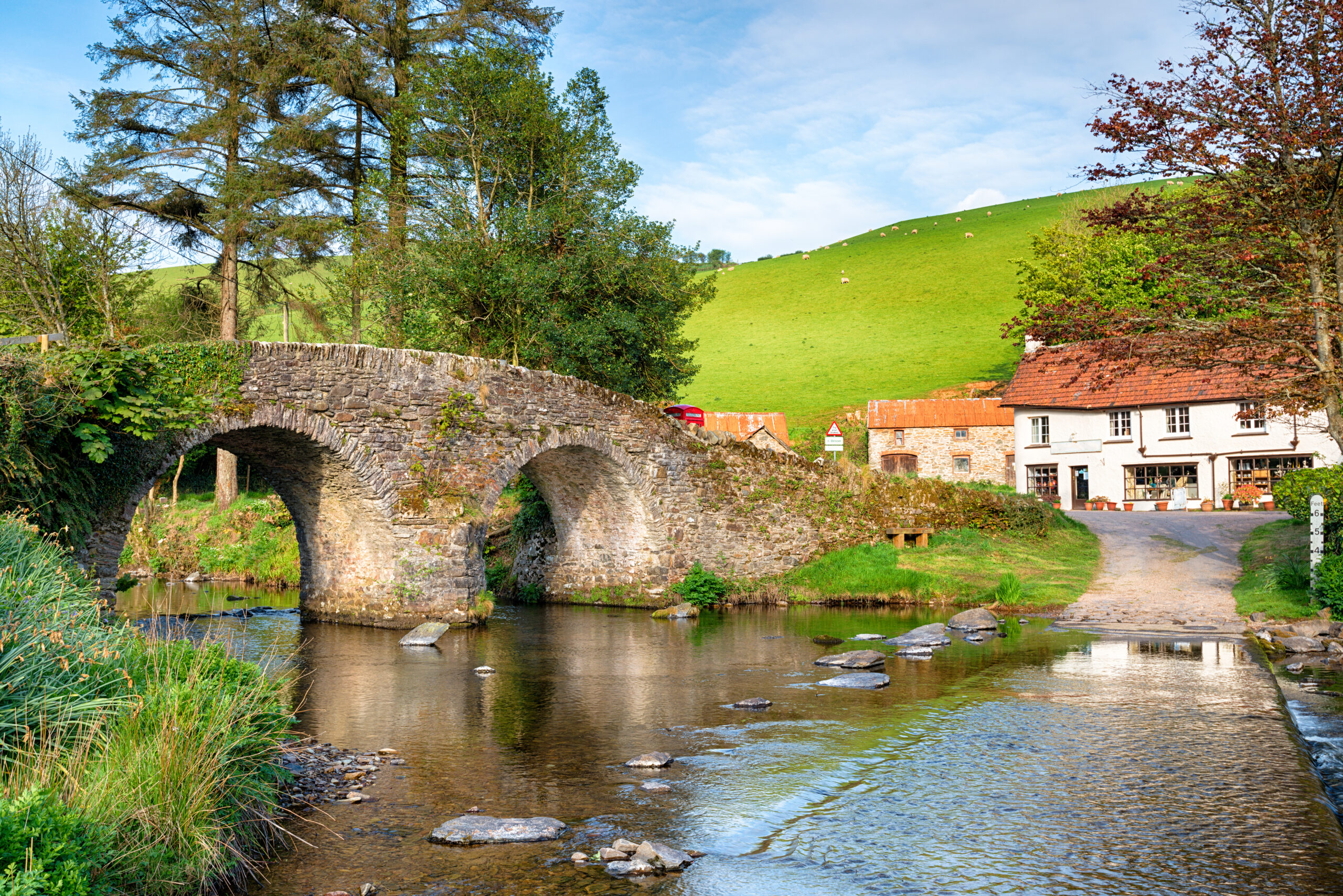On the south coast of England, just before you reach the famous Cornwall, lies the idyllic county of Devon, a real gem. Devon is best known for its picturesque hills, picturesque fishing villages and the Dartmoor and Exmoor National Parks.
The land here seems older, wilder and more pristine than in the east and between the famous tors of Dartmoor – bizarrely shaped granite formations that are said to have been haunted by the devil – the Norman cathedral in Exeter and the many hidden prehistoric beauties of Devon, travelers will find all their wishes fulfilled in mystical England.
If you are looking for evidence of the past, for sagas and legends, Devon is the place for you. The county was one of the first regions in England to be settled at the end of the last ice age. The first hunter-gatherers were on Dartmoor as early as 6,000 BC. The remains of their villages can still be admired today in the rugged and barren landscape.
Tourism has also found its way into Devon, as more and more people are attracted by the beautiful landscape and historical sights of Devon. As one of the largest counties in England, Devon has much to offer, including 500 kilometers of coastline with some of the most beautiful sandy beaches in England. Also worth seeing is the Jurassic Coast, a UNESCO World Heritage Site with impressive rock and coastal formations.
Dartmoor National Park
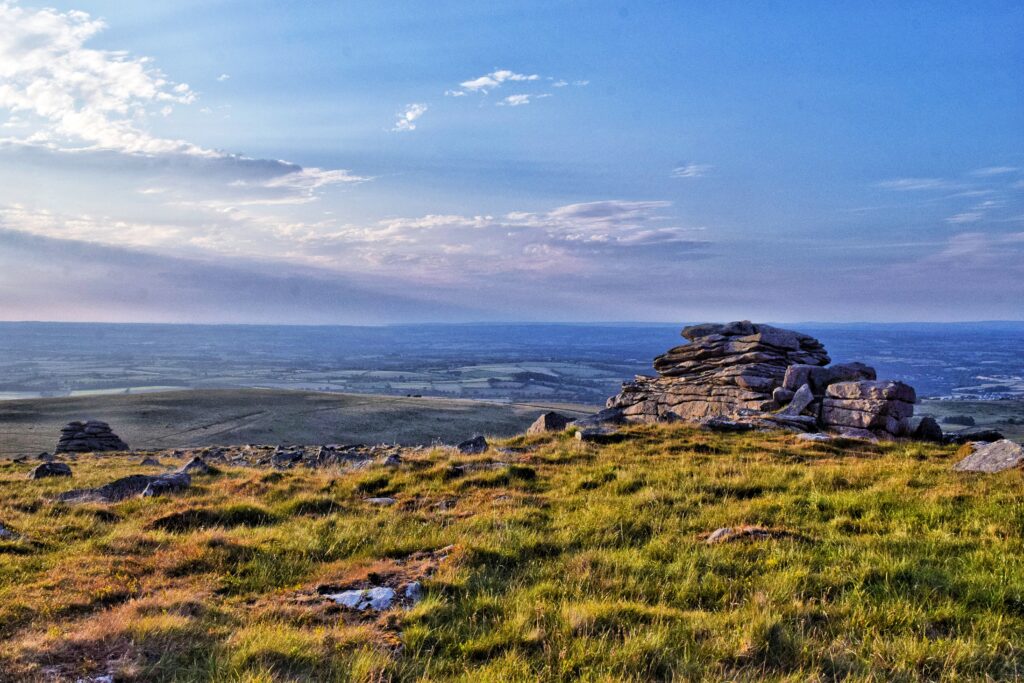
Where Devon meets Cornwall in southern England lies the mystical landscape of Dartmoor. The wild moorland stretches over an area of 954 square kilometers and has many prehistoric sights to offer in addition to a lot of seemingly untouched nature. Nowhere else in Great Britain can you find so much evidence of prehistory and early history as on Dartmoor.
When the first settlers arrived in the area that is now moorland in the Neolithic period, there was a large forest here. The settlers cleared the trees and settled down. However, as the soil was hardly suitable for agriculture, they mainly raised livestock here.
It is hard to find a more mysterious and mystical place in southern England than Dartmoor, which is often traversed by low-hanging mists. You might think you can make out figures in the veils of mist and so Dartmoor is shrouded in many myths and legends, which are still told in many places today.
The many prehistoric sights make Dartmoor a very special place. There are many stories of this kind on Dartmoor. No wonder, as the stone circles, cairns, stone rows and settlement remains offer more than enough inspiration. The Upper Erne Stone Row, the longest stone row in the world (3.3 km), is particularly impressive.
However, the pristine landscape also has its pitfalls: When planning walks across Dartmoor, never set off unprepared.
Jurassic Coast
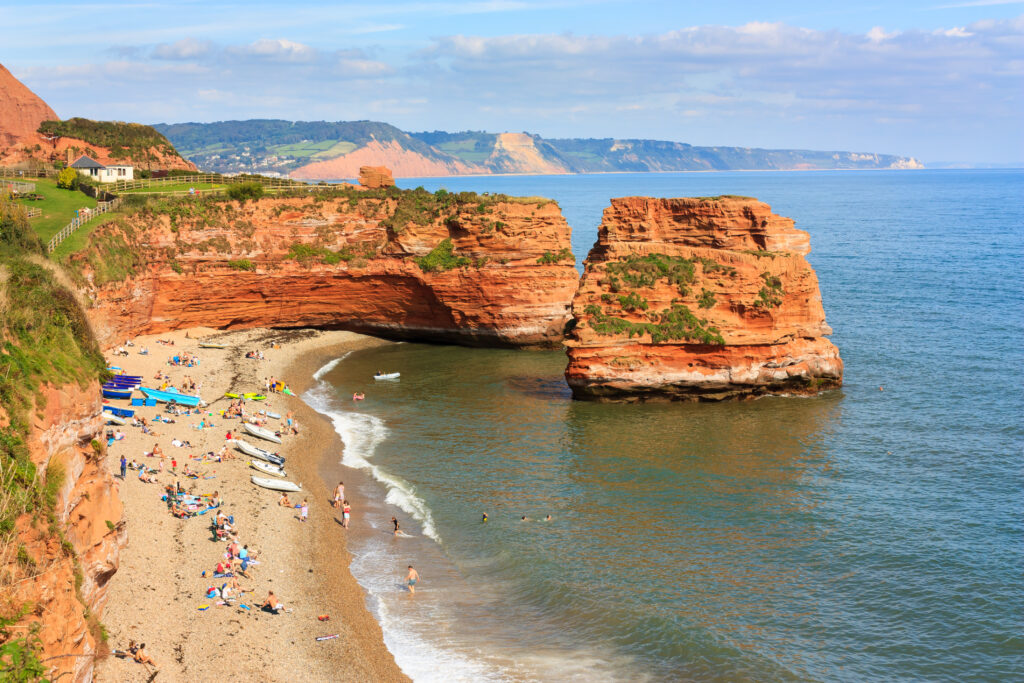
The southwest of England is famous for its picturesque landscapes: rolling green hills in the hinterland and a coastline that always shows a different face – with spectacular cliffs, bizarre rock formations or gentle dunes. Fantastic bays with fine sandy beaches and calm waters tempt you to take a refreshing dip in summer. In the charming fishing villages, quaint pubs and cozy tearooms invite you to linger after a long walk on the beach and fortify your guests with delicious scones or sandwiches.
Most people are sure to immediately think of Cornwall when they see these images. But the southwest of England has even more to offer – especially on the mysterious Jurassic Coast. This extraordinary stretch of land is located in the counties of Devon and Dorset and stretches for 155 kilometers along the coast. The Jurassic Coast begins at the cliffs of Orcombe Point near the town of Exmouth and ends at Studland Bay with its miles of lovely sandy beach and the imposing chalk pillars of Old Harry’s Rocks on the Isle of Purebeck peninsula.
These 155 kilometers of coastline have it all: they are England’s first UNESCO World Heritage Site and offer unique insights into our geological history. The oldest layers of rock can be found in the west of the Jurassic Coast. The local sandstone dates back to the Triassic period around 250 million years ago.
Ilfracombe
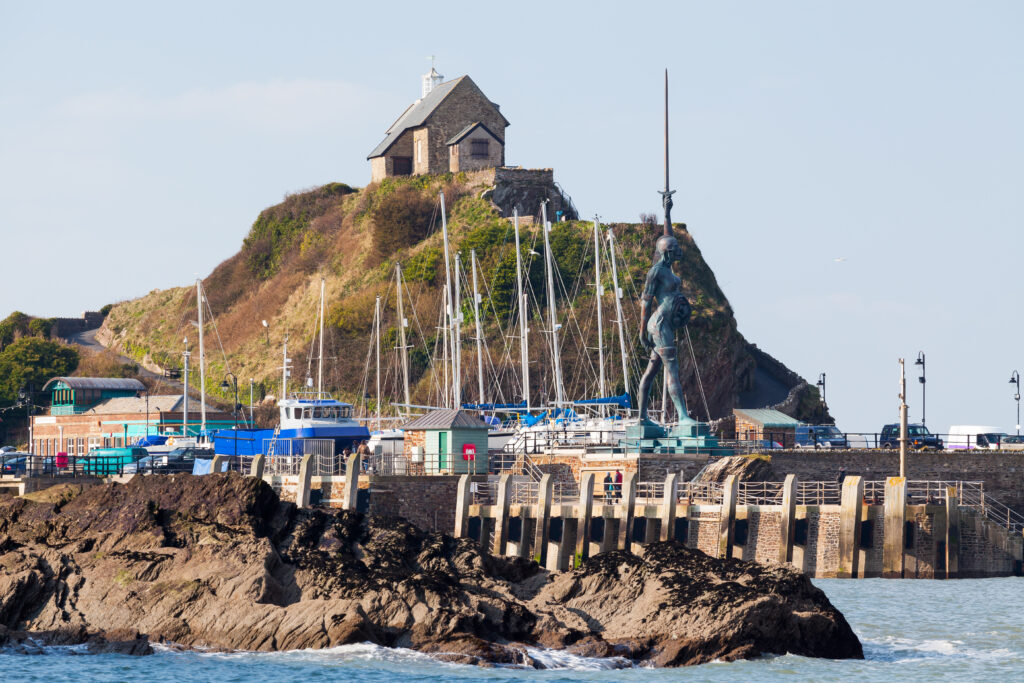
Ilfracombe is located right on the coast in the north of Devon. It is a picturesque area that is very different from the south of Devon. The steep cliffs, on which the waves of the sea break with a roar when the wind blows, conjure up a somewhat rugged yet romantic area. It is an image that remains in your memory when you drive along the coast in the sunshine or let your gaze wander over the area on one of the many hiking trails.
Ilfracombe is a typical vacation resort: many small hotels and B&Bs line the streets right into the town center and many a hotel looks down from the hills onto the town and the sea. From the beach, you can look across to Wales. This is also where many of the workers who built the famous Beaches Tunnels came from. The four tunnels, which were cut into the rocks by the workers in 1823, are the only access to this part of the sea with its small beach.
St. Nicholas’ Chapel is located on the hill by the harbor, which can be climbed on foot and offers a beautiful view. The streets around the small historic harbor are lined with small cafés, restaurants and stores in Victorian buildings. Ilfracombe harbour is also home to the famous and controversial statue by artist Damien Hirst, Verity, which stands 20 meters tall and looks out to sea.
Hartland Peninsula
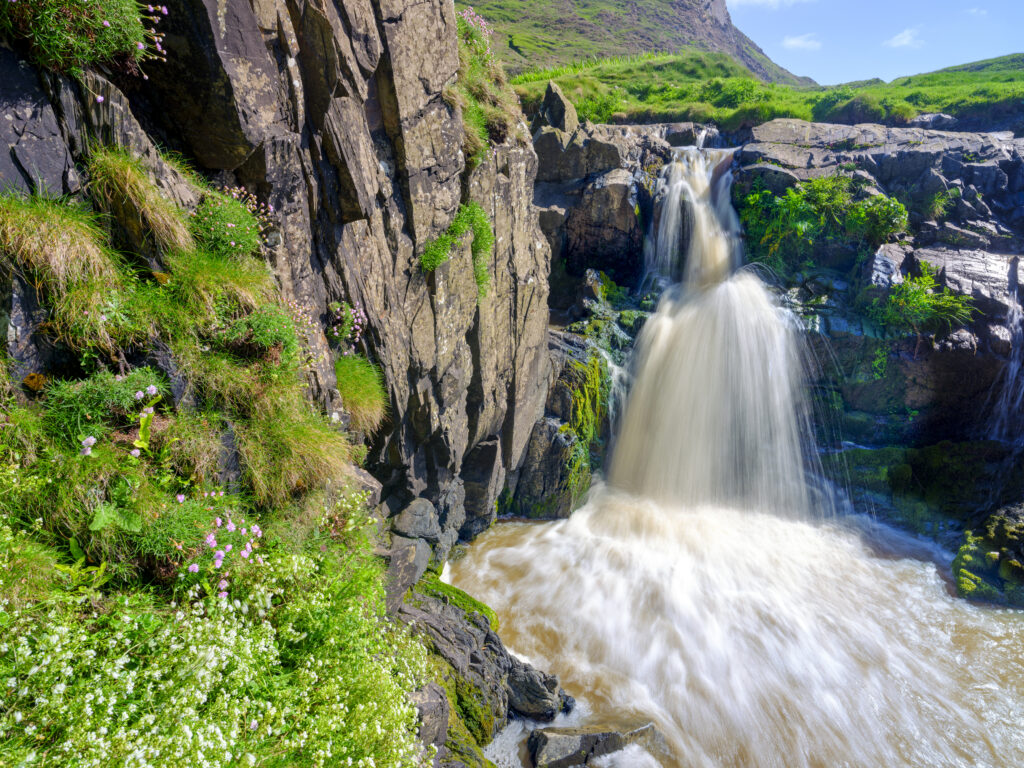
Hartland Point is the most north-westerly point in Devon: A headland characterized by its impressive coastal landscape, consisting of high cliffs, steep slopes and rock formations. Hartland Quay lies to the south of this. However, the place is notorious for its rough waters and dangerous coastal formations, which has led to many shipping accidents. Nowadays, Hartland Quay is a popular destination for tourists who want to experience the dramatic coastal landscape.
Both places are located in the Hartland Devon Heritage Coast, an area known for its high cliffs, steep escarpments, rocky coastal formations, coves, beaches and diverse wildlife.
Hartland Point is a headland on the north coast of Devon in England. It marks the western entrance to Bideford Bay, which is part of the Bristol Channel. The area around Hartland Point is characterized by its impressive coastal landscape, which consists of high cliffs, steep slopes and angular rock formations. Hartland Point is also known for its beautiful lighthouse, which was built in 1874.
Not far from here is Hartland Quay, a former harbor with a pub, hotel and museum. There are also spectacular views of the sea and the surrounding countryside.
The entire Hartland Devon Heritage Coast is a popular destination for walkers, nature lovers and history buffs.
There are footpaths along the coast that offer breathtaking views and numerous coves and beaches.
Lynton and Lynmouth
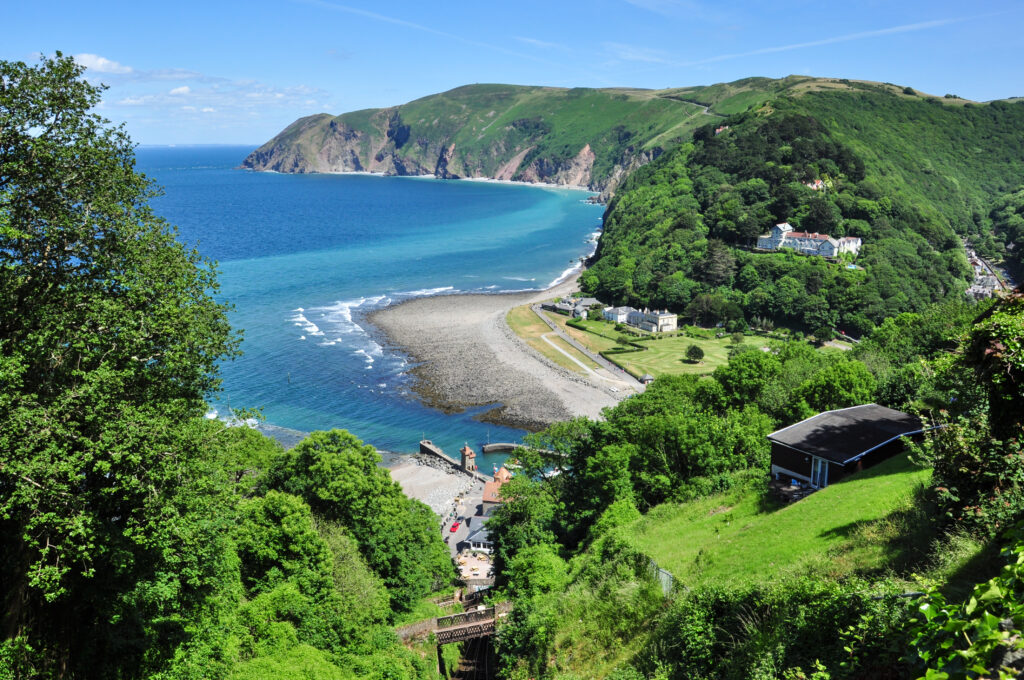
The enchanting twin towns of Lynton and Lynmouth, nestled between the mountains of Devon’s stunning north coast, form a harmonious combination of picturesque beauty and historic charm. These closely linked towns are renowned not only for their stunning coastal scenery and impressive cliffs, but also for their unique sights and walking opportunities.
Lynton sits majestically on the cliffs, offering breathtaking panoramic views of the coastline and is a popular destination for anyone wishing to enjoy the dramatic scenery in the area. It is also home to the famous Lynton & Lynmouth Cliff Railway, a historic water ballast train that takes you from the village down to neighboring Lynmouth. With its charming houses, Lynton offers a relaxed atmosphere for strolling and lingering.
Lynmouth also impresses with its picturesque location: directly on the rivers East and West Lyn and the spectacular coastline, this town is also a popular destination. The combination of historic architecture, natural beauty and cozy lanes gives Lynmouth a unique appeal. Particularly impressive is Glen Lyn Gorge, where you can experience waterfalls and rapids. The charming Rhenish Tower, a Victorian-era tower, is another landmark that tells the history of the towns.
Woolacombe Beach
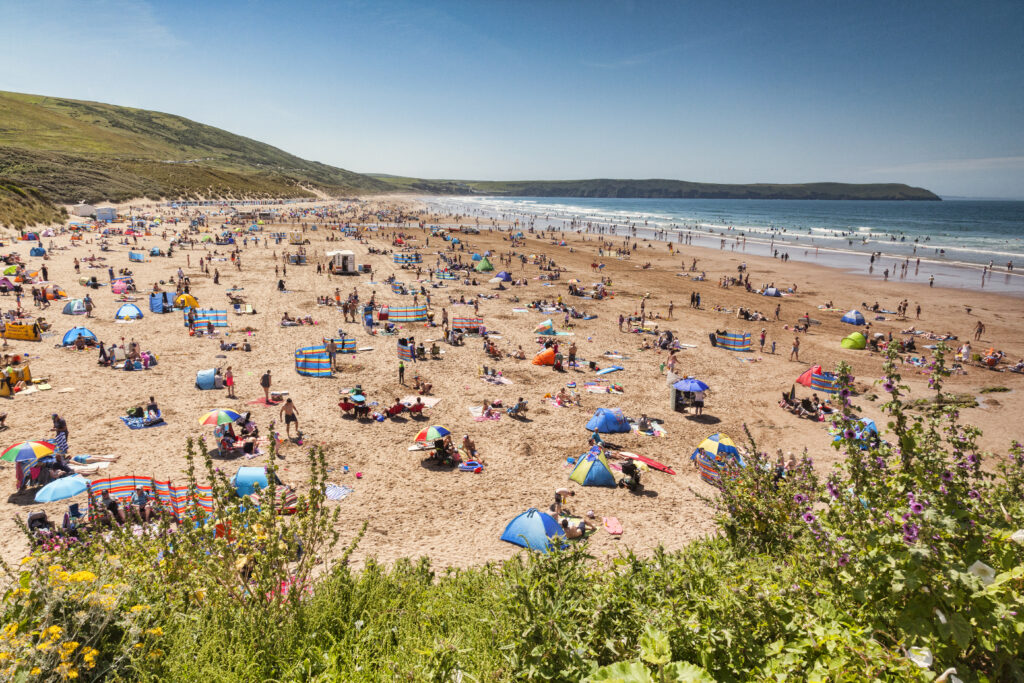
The charming seaside resort of Woolacombe on a valley inlet on the North Devon coast offers great water sports activities and beautiful nature.
At Woolacombe beach you can fly kites, surf the waves or simply relax in the sun. For a thrill and an unforgettable view, take a tandem kite flight over Devonshire. If you don’t feel like taking to the skies, take a boat trip to Lundy Island and discover the bird and animal life there. A sea safari along the coast is a special experience – seals and dolphins frolic in the water here.
A walk along the 3-kilometer-long sandy beach of Woolacombe Beach is a wonderful way to unwind. Water rats can swim a lap in the gentle waves at low tide or plunge into the cool water at high tide. The stronger waves then offer ideal surfing conditions. Beginners can take a course at a surfing school – while board artists can let off steam on the sea to their heart’s content.
Those who prefer to stay dry can take part in a boat trip. On a surf safari, you can see the North Devon coast from a unique perspective as you ride the waves. You might even catch a glimpse of seals or dolphins. The MS Oldenburg will take you to Lundy Island, where you can discover the local bird and animal life and then relax in the tavern with a cold beer.
Exmoor National Park
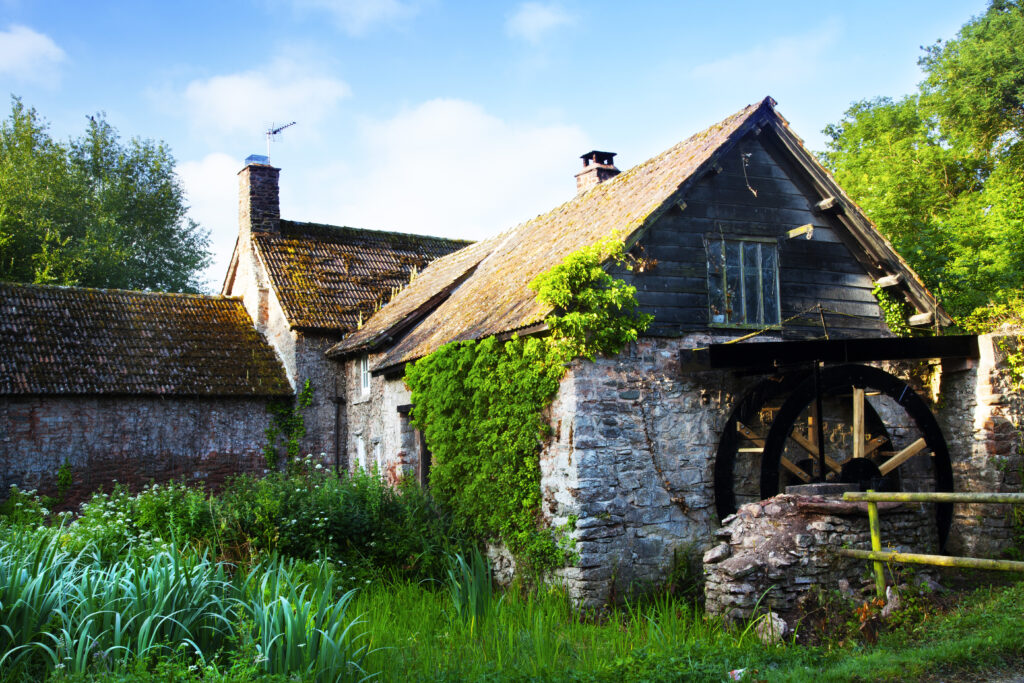
Exmoor National Park in England is known for its rolling hills, pretty valleys, wild rivers and stunning coastline. You’ll find a mixture of vast heathland, lush forests and picturesque villages. The landscape in Exmoor National Park is characterized by moors where you can spot free-roaming Exmoor ponies, cows, sheep and other animals. The vastness of nature and the pleasant, fresh air invite you to take long walks and enjoy the peace and quiet.
Exmoor National Park in England has a lot to offer: In the villages surrounding the national park, you’ll find charming tea rooms, traditional pubs and regional craft stores. One of the national park’s most notable features is its beautiful coastline, which offers spectacular views of the deep blue sea.
Exmoor National Park in England is an absolute hiker’s paradise: Whether you’re an experienced walker or prefer a short stroll, Exmoor National Park is the ideal place to hike. With over 1,000km of trails leading through mystical woodlands, along the spectacular coastline, beside rushing rivers or across open, heather-covered moorland, the variety is endless.
Lundy Island
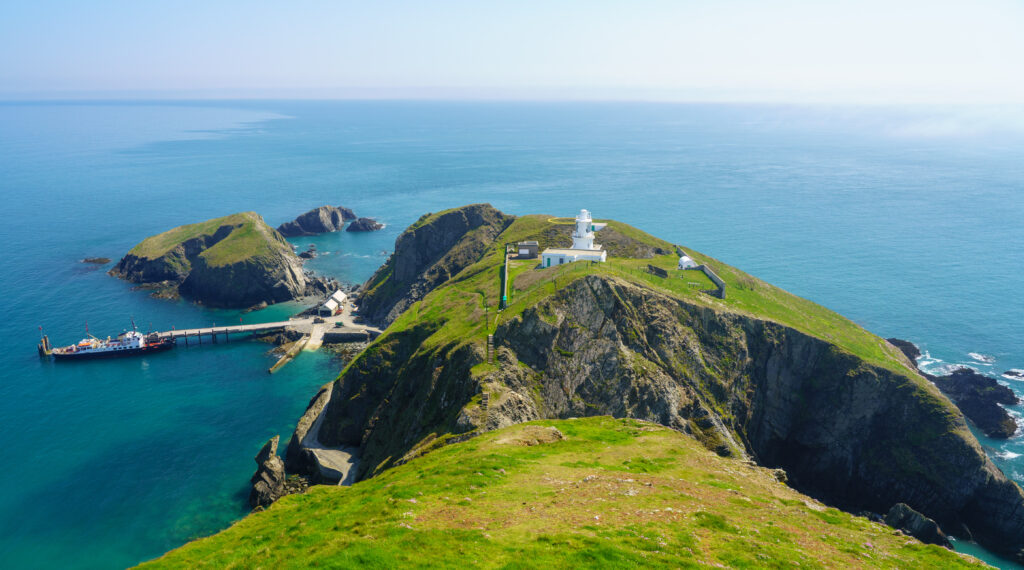
Lundy, the island for switch-offs, short drop-outs and submersibles, is located at the entrance to the Bristol Channel and belongs to the county of Devon. The island is 4.5 km long from north to south and only about 1 km wide. With an area of 4.25 km², it is nevertheless the largest island in the Bristol Channel and is one of the most frequently mentioned natural wonders of Great Britain.
Tibbett’s Hill is its highest point at 142m. The tiny village of Lundy Village is home to the Marisco Tavern, which claims to never close. This is where the delicious Lundy beer is sold (although it is brewed on the mainland).
Due to the decline in population on the island, the British Post Office lost interest in renewing the postal contract with Lundy in 1927 and closed the last Post Office. The then owner of the island, Martin Harman, who had previously proclaimed himself king of the island, therefore decided to take postal traffic into his own hands and finally issued his own stamps on November 1, 1929.
Although the British Post Office does not accept the stamps, they have become a sought-after collector’s item over the years.
Lundy’s species-rich wildlife includes many seabirds such as various species of gulls and the puffin.
Grey seals, Sika deer, Soay sheep, feral domestic goats and the Lundy pony also feel at home on the island.Climbing enthusiasts will also find some of the best climbing opportunities on Devon’s sea cliffs here.
Dartmouth
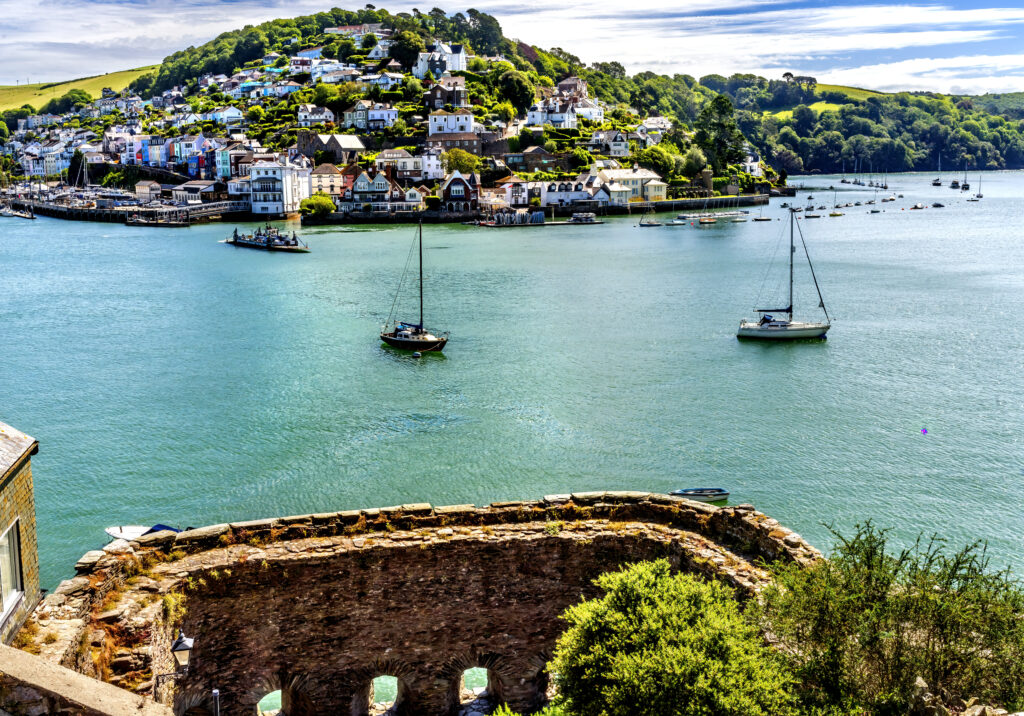
The town has been an important base for British shipping over the centuries. Even the Pilgrim Fathers, who once set off across the Great Pond to the New World on board the Mayflower, have links with Dartmouth, as they stopped off in the town to repair their two ships before leaving their old home behind for good.
Not only trade via the port of Dartmouth, but also fishing played an important economic role in the development of the town and the surrounding area. Today, the many historic buildings in Dartmouth bear witness to this history.
Naval officers have been trained at the Royal Britannia Naval College in Dartmouth since 1863. Initially, the Britannia itself was also moored in the harbor and used for training.
Today, tourism is of particular importance to Dartmouth. In the 19th century, the rail network expanded throughout England and brought holidaymakers from all over the country – including to Dartmouth. This development really took off at the beginning of the 20th century. To this day, Dartmouth enjoys an uninterrupted flow of travelers, as does the entire English Riviera area on the Devon coast.
Salcombe
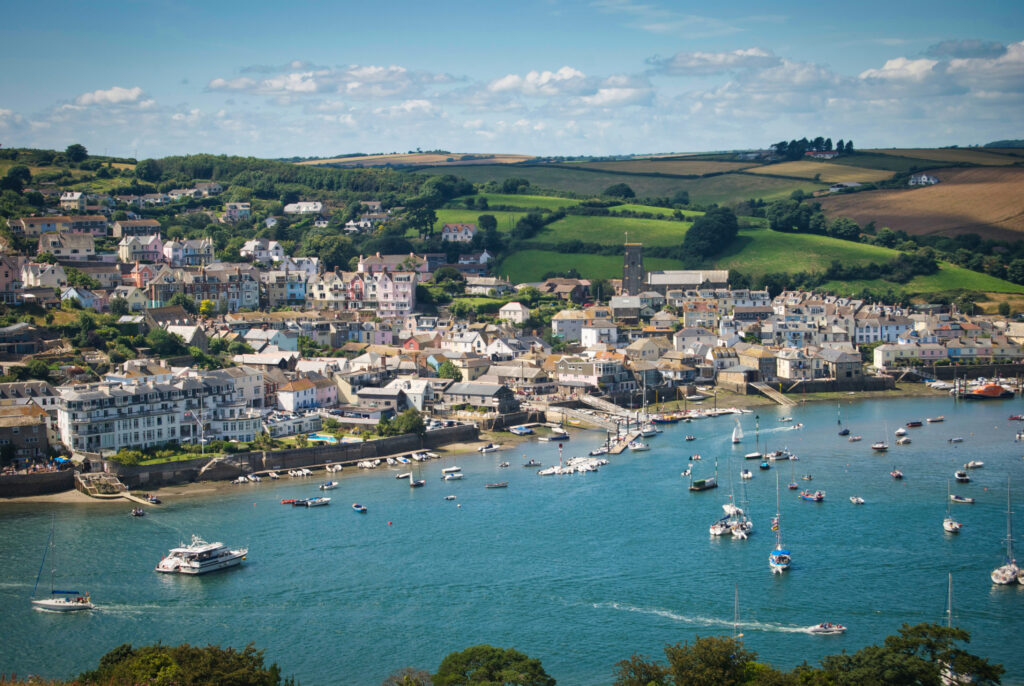
It’s like the Mediterranean – only more beautiful! Right on the south coast of England in the county of Devon, just outside Cornwall, lies the lovely town of Salcombe on the banks of the Kingsbridge Estuary, just before it flows into the English Channel. No wonder this area is also known as the “English Riviera”.
The Estuary forms a natural harbor here, surrounded by wonderful hilly terrain. No matter where you look: The blue of the water always blends with the green of the surrounding meadows and the bright colors of the boats. Salcombe also offers lovely beaches and a very special boat service: The “Sea Tractor” takes you from the town center to the beach and back. A special vehicle is first climbed onto the shallow beach so that it is easy to get on board, which then rolls into the deeper water and allows you to transfer directly onto the boat.
Not far from Salcombe is “Overbecks Garden”. This is a nice place, but instead of paying the entrance fee, we recommend an extended (free) hike across the meadows and cliffs along the coast. Fantastic views reward you at every turn and invite you to return.
Totnes
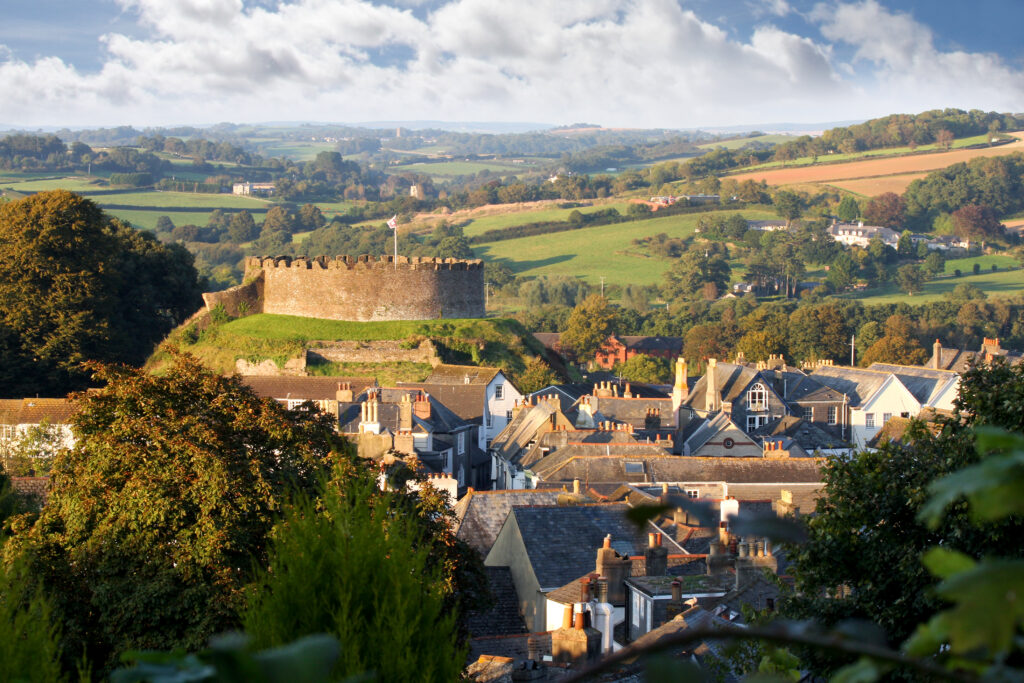
Totnes is located on a hill, right at the mouth of the River Dart, over which a bridge leads to the suburb of Bridgetown, connecting the two. The town is a true paradise for followers of the “New Age” movement, for anyone looking for a break, who likes to stroll through alternative stores, who values organic food and lives in an environmentally conscious way. Totnes, with its historic merchants’ houses and Tudor buildings, is set in beautiful Devon surroundings and has a history dating back to well into the Middle Ages.
The history of Totnes begins at a mythical time, with the Brutus Stone, a small granite boulder now located on Fore Street in Totnes. The Trojan prince Brutus is said to have stepped on this stone when he left his ship and gave the town its name. At least that is what Geoffrey of Monmouth reports in his “Historia Regum Britanniae” from the 12th century.
Due to its location on the estuary and on an old trade route, Totnes had already developed into a flourishing market town by the 12th century and was an important trading town in the area.
To this day, Totnes has retained its importance as a market town, with regular market days still taking place. Above all, however, Totnes is now a place for culture and art, music and theater – and for an alternative lifestyle. The town is known for its alternative community and for the fact that you can lead a New Age lifestyle in Totnes.
Exeter
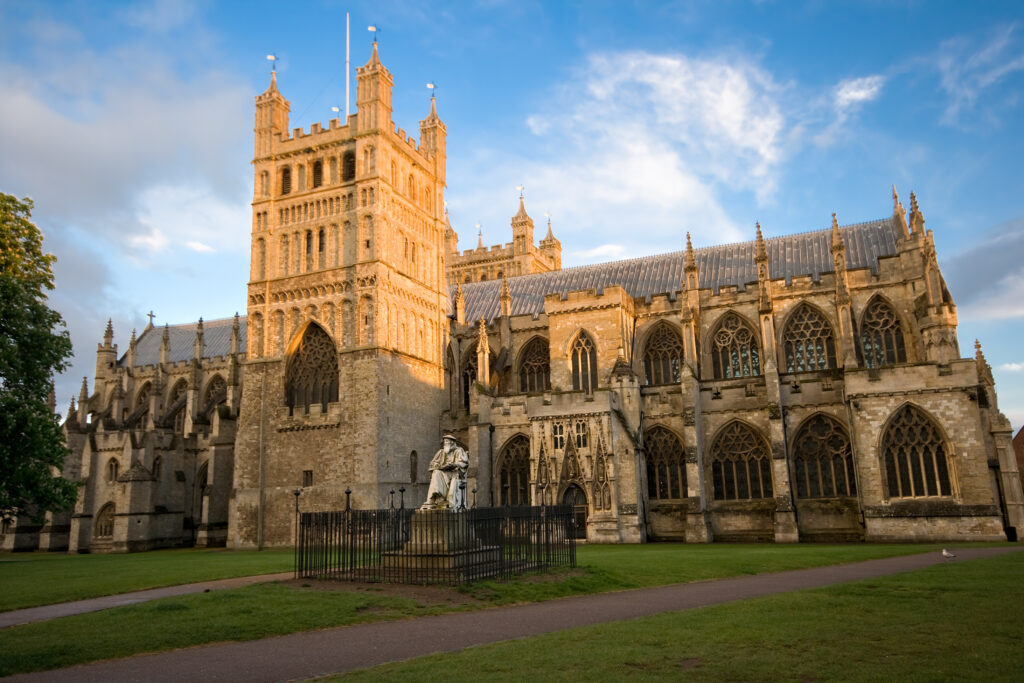
Exeter was founded by the Romans. The remains of the old city wall from those days still bear witness to this today. You can even walk along sections of the wall, for example if you follow the signs for the City Wall behind the cathedral at Palace Gate, right across South Street. In Roman times, the city wall was already part of a fortress that surrounded the city.
After the Romans left Britain, first the Anglo-Saxons and later the Normans followed in their footsteps. Under William the Conqueror, a castle was built in Exeter just a few years after the conquest of England. The Normans then began building Exeter Cathedral around 1114.
By the 12th century, Exeter had already achieved an important economic position due to trade and shipping on the adjacent River Exe. During the Tudor period in particular, Exeter grew into a wealthy city. The reason for this was the wool industry, which brought wealth to the citizens of the city and was also reflected in the houses from this period.
Today, Exeter is a city with a rich cultural offering, which is further enhanced by the many students at Exeter University. The many historic buildings, museums and attractions make Exeter a very worthwhile destination.
English Riviera
Torquay
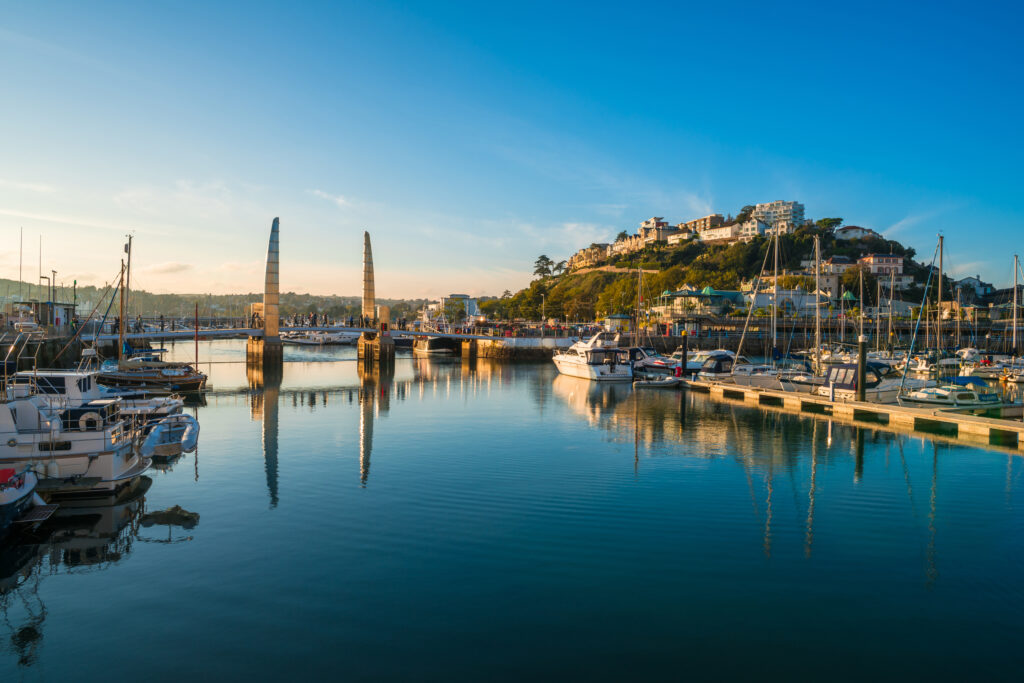
Torquay already enjoyed a reputation as an excellent seaside resort in the 19th century, when many places throughout the country began to become seaside resorts and the railroads brought holidaymakers to the spa regions. This fortunate circumstance dates back to the beginning of the 19th century, when Napoleon also made the English sweat and made travel to the continent, as they say, impossible for the upper ten thousand of the British Isles. So they were forced to look for alternatives in their own country.
Torquay itself is built on a total of 40 hills. It stretches along the coast, with steep cliffs leading upwards. But it is not just the number of hills that is superlative. Torquay also has a total of 20 beaches spread over a stretch of 35 km, where you can also enjoy excellent beach walks. Above the harbor is the famous Rock Walk, where you can stroll along the cliffs overlooking the sea and enjoy an excellent view over the bay.
In the Babbacombe district, a wooden cable car rattles up a 73 m high cliff. It is mainly the locals who are drawn to the beach here.
Brixham
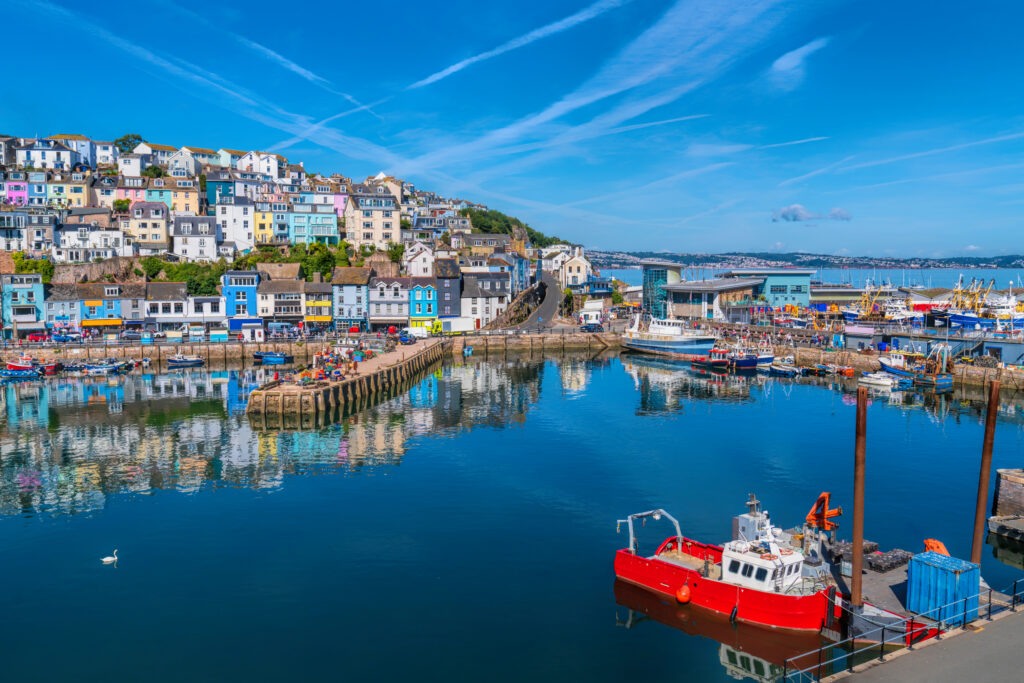
Brixham has retained the charm of a traditional fishing village and looks back proudly on its maritime past. Napoleon was stuck on a ship off Brixham for weeks before he was shipped into exile to St. Helena by the British and a replica of Sir Francis Drake’s “Golden Hind”, with which he sailed around the world in the 16th century, lies in the harbor. The big pirate festival takes place on the Bank Holiday weekend in May. The walk out to the lighthouse at Berry Head is a must.
Paignton
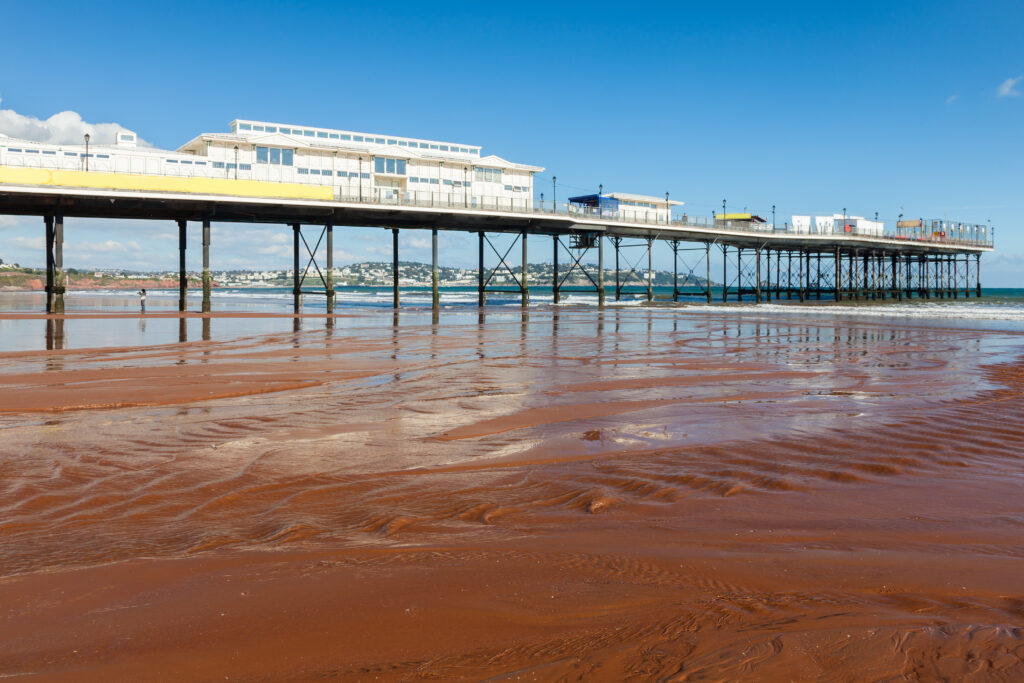
Paignton has seen its best days as a seaside resort, but the beach alone is reason enough for a trip. In the middle is the Paignton Pier from the late 19th century, which like most English piers is now a brightly colored amusement park for children.
In short, the English Riviera can’t necessarily compete with Cornwall or the beaches of Wales in terms of natural beauty, but the sheltered location and the many entertainment options make Torquay in particular a good choice for a few days’ vacation by the sea.
Clovelly
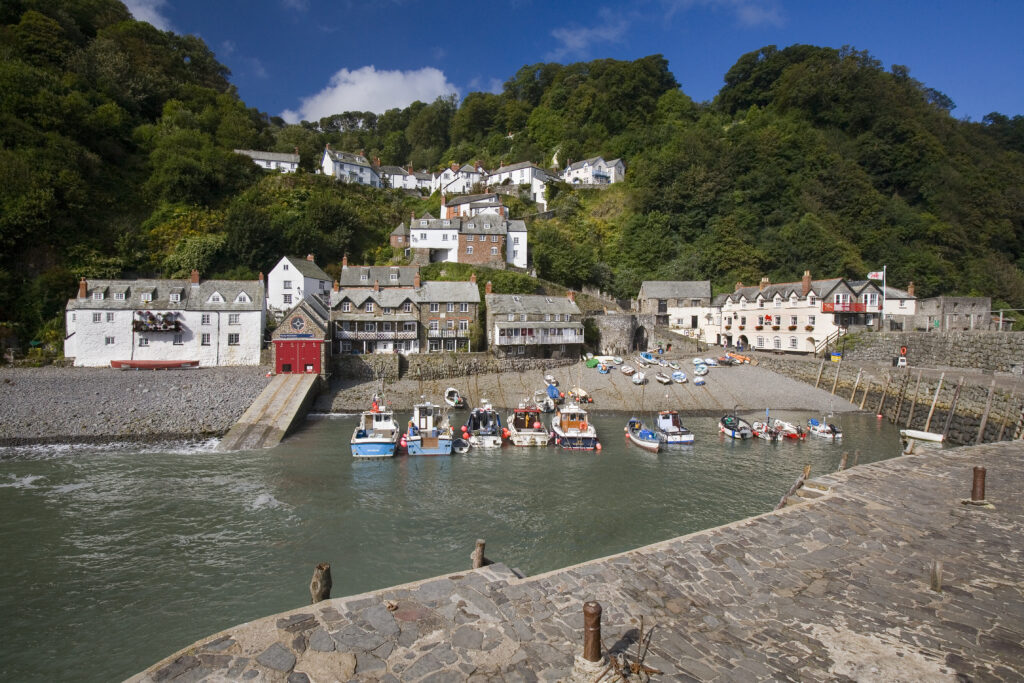
Clovelly is one of Devon’s most picturesque villages. It is located on Devon’s north coast and is a privately owned village, which has helped to maintain its original atmosphere. When you visit Clovelly, it’s like going back to the 19th century. Cars are not allowed in the steep, narrow streets of the village, which are framed by quaint, whitewashed cottages and colorful flowers.
The tiny picturesque harbor has an 18th century quay built to protect the fishing boats that caught herring in the 18th and 19th centuries. You can walk along the pebble beach, enjoy magnificent sea views and watch a waterfall cascade over the cliff face. Merlin, the wizard of Arthurian legend, is said to have been born in the ravine behind it.
Clovelly Court Garden is a wonderful example of a Victorian walled herb garden with magnificent glasshouses. The unique maritime microclimate and sheltered location allow delicate and exotic plants to flourish.
In front of each of the houses are sledges used by the families and businesses in Clovelly to bring goods and supplies into the village and take away garbage. The donkeys once carried the fishermen’s heavy baskets to the top of the village, but now offer donkey rides to children during the summer months.
Plymouth
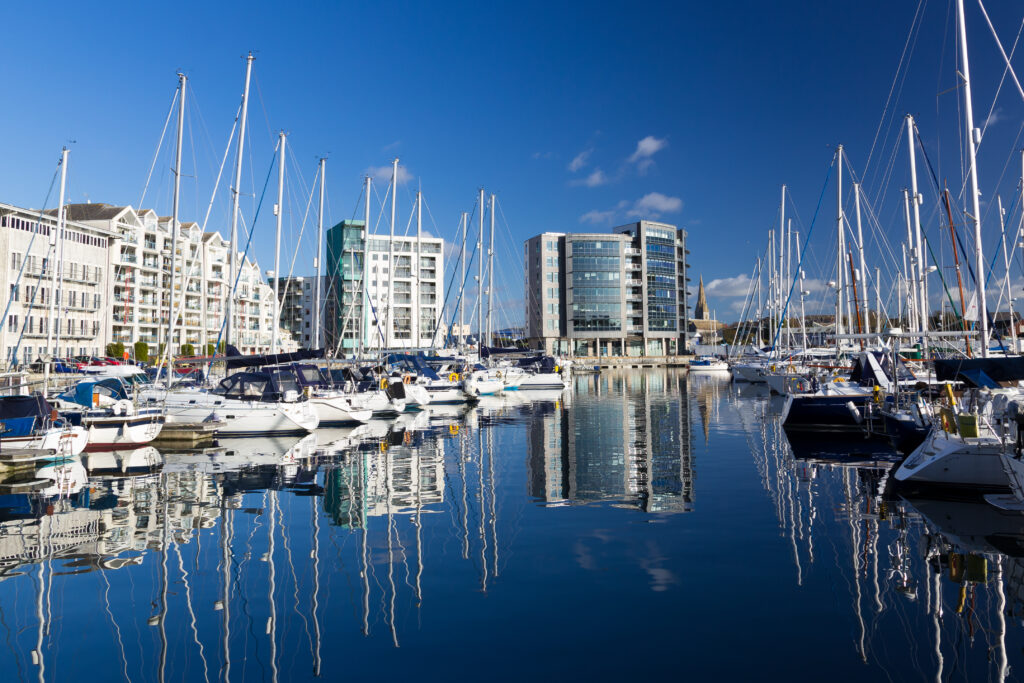
Plymouth is Devon’s largest city and one of Britain’s greatest seafaring towns, dating back to the 16th century. Devonport is home to the Royal Navy and ferries sail from Plymouth to France and Spain.
High above the harbor and overlooking Plymouth Sound, the Hoe is a wide grassy expanse, ideal for picnics. Here you will find Drake’s statue; Sir Francis Drake was born in Tavistock around 1540 and went on to become the most famous sailor of the Elizabethan age and one of the world’s greatest sailors.
Sutton Harbour is the original port of Plymouth; Captain Cook began his voyages from here, the Pilgrim Fathers also sailed from here and their voyage is commemorated by the Mayflower Stone and steps. Today the marina has some great bars and restaurants where you can sit back and watch the world go by.
The historic Barbican area of the city consists of a fascinating maze of narrow old streets and alleyways that have been preserved from Elizabethan times. There are plenty of cafes, bars and restaurants, and here you will also find the Plymouth Gin distillery, which has been producing the famous Plymouth Gin since 1793. There are guided tours of the distillery, as well as a store, bar and restaurant.
The National Marine Aquarium is the largest in the UK and offers a fascinating display of marine life, from sharks to seahorses, stingrays and corals. The aquarium is one of Plymouth’s best visitor attractions and a great destination for a family day out.

